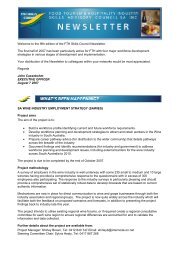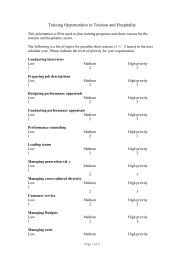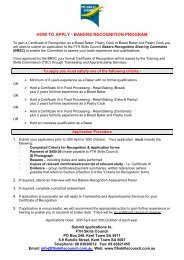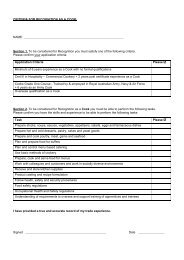SA Major Projects & Workforce Impacts - FTH Skills Council
SA Major Projects & Workforce Impacts - FTH Skills Council
SA Major Projects & Workforce Impacts - FTH Skills Council
Create successful ePaper yourself
Turn your PDF publications into a flip-book with our unique Google optimized e-Paper software.
Current <strong>Workforce</strong> Skill Level<br />
Percentage of the <strong>Workforce</strong><br />
Yr 10 Trade Degree<br />
Future <strong>Workforce</strong> Skill Needs<br />
These graphs show the need to upskill South Australia’s workforce to meet<br />
the higher skills levels required to keep businesses globally competitive.<br />
The skills demanded across the economy are changing.<br />
There is a greater call for higher skill and qualification levels<br />
and for more specialised positions to be filled. The graphs<br />
above show how the workforce skill levels must increase<br />
to meet the demand of these projects. Businesses must<br />
be aware of the need to begin planning and changing<br />
organisational culture to minimise the impacts of the<br />
workforce challenge facing the state.<br />
Percentage of the <strong>Workforce</strong><br />
Yr 10 Trade Degree<br />
Supply and Demand<br />
Conservative estimates suggest the demand for labour<br />
(workers) in South Australia will outstrip supply within ten<br />
years. In its most simple terms this means there will not be<br />
enough people to do the work! South Australia’s ageing<br />
population is one of the key reasons for this problem.<br />
Australian Bureau of Statistics (ABS) and other government<br />
data show that <strong>SA</strong> has the oldest population of all states and<br />
is aging more rapidly than the rest of the nation. This problem<br />
is being faced in most developed nations around the world.<br />
Projected Demand and Supply of Labour in South Australia<br />
People Required 000’s<br />
900<br />
800<br />
700<br />
2007 2025<br />
2017<br />
Demand<br />
Labour “Gap”<br />
Supply<br />
Arrow indicates how major projects<br />
increase labour demand and reduce<br />
the time to demand exceeding supply<br />
The graph (based on DFEEST 2007 estimates of ABS and Monash Centre of Policy<br />
Studies data) shows how new major projects may shorten the time before demand<br />
outstrips supply.<br />
The <strong>SA</strong> <strong>Major</strong><br />
<strong>Projects</strong> Matrix<br />
The <strong>Workforce</strong> Impact <strong>SA</strong> <strong>Major</strong> <strong>Projects</strong> Matrix is a snapshot<br />
of the major projects in <strong>SA</strong> by industry sector and by region,<br />
as at April 2007.<br />
The matrix includes projects nearing completion as<br />
well as those approved, but not yet commenced. Each<br />
project is listed with their dollar value in millions, with an<br />
indication of whether it is likely to have a major impact in<br />
the areas of employment, skills and training, construction,<br />
accommodation and housing, transport, infrastructure, health<br />
and community services, and power. The impact of a project<br />
can be much greater in a regional area where services and<br />
infrastructure are constrained.<br />
Industry and businesses can use the matrix to consider the<br />
impact of major projects from a positive (business generating)<br />
point of view and also from a risk management perspective.<br />
The matrix provides policy makers and government agencies<br />
with an overview to best focus regional resources, and<br />
enables training and education providers to pinpoint projects<br />
and regions where skills and employment are going to be<br />
in the greatest demand. The population and employment<br />
figures included by region also give a good understanding of<br />
some of the labour supply issues. Comparing the variation<br />
in unemployment from 2.2% on Kangaroo Island to 8.3%<br />
in Northern Adelaide (with 50 times the population) is<br />
enlightening when considering labour pools for projects.<br />
It is also hoped the matrix will be used as an educational tool<br />
in schools, in further education and by universities as well as<br />
a tool for job hunters, consultants and contractors who may<br />
target a project or region.<br />
During this project the Industry <strong>Skills</strong> Boards became aware<br />
of at least 20 projects under consideration that will shortly be<br />
approved or become public. It is likely that local councils and<br />
regional businesses have access to information regarding<br />
other major projects which may need to be included.<br />
<strong>SA</strong> <strong>Major</strong> <strong>Projects</strong> & <strong>Workforce</strong> <strong>Impacts</strong>













